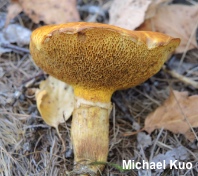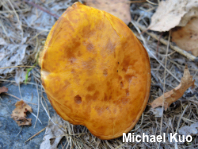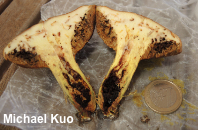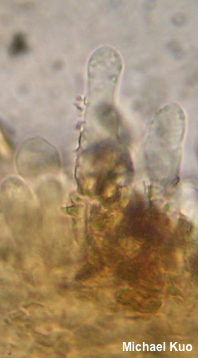| Major Groups > Boletes > Suillus > Suillus tridentinus |

|
Suillus tridentinus [ Basidiomycota > Boletales > Suillaceae > Suillus . . . ] by Michael Kuo Look for Suillus tridentinus under European larch in the Alps and the Carpathians. Its orange cap and pore surface make it fairly easy to distinguish. On the stem there is a collapsing whitish ring and an orange, reticulate apex. The cap surface usually features scattered fibrillose patches, especially near the margin. Compare Suillus tridentinus with other European larch-associated Suillus species: Suillus viscidus features a gray to pale grayish brown cap, and a whitish pore surface; Suillus bresadolae features a gray pore surface and a reddish brown cap; Suillus grevillei has a dry cap ranging from yellow to brownish red, and a bright yellow pore surface composed of smaller, rounder pores. Finally, Suillus tridentinus flavogriseus, sometimes called Suillus nueschii, features a yellow cap and stem with a whitish veil. Description: Ecology: Mycorrhizal with European larch; growing alone or gregariously; fall; originally described from Italy; probably widespread in the Alps and the Carpathians, throughout the natural range of the host tree. The illustrated and described collection is from Italy. Cap: 5–9 cm across; broadly convex; sticky when fresh; bald, or with fibrillose areas, especially near the margin; brownish orange to orange; staining waxed paper yellow. Pore Surface: Bright orange when young, becoming duller orange with maturity; pores large and angular, about 1–2 mm in length, in boletinoid (radial) arrangement; tubes to about 10 mm deep. Stem: 4–6 cm long; 1–2 cm thick; more or less equal above a tapered base; colored like the cap; with a collapsing, gelatinized, whitish ring; often reticulate above the ring; basal mycelium whitish. Flesh: Pale yellow to orangish in cap and upper stem; darker yellow or orange in stem base; when sliced sometimes turning a little bluish in lower stem. Odor and Taste: Not distinctive. Microscopic Features: Spores 8–14 x 3.5–5 µm; boletoid-fusiform; smooth; yellowish in KOH. Basidia 20–25 x 4–6 µm; subclavate; 4-sterigmate. Cystidia mostly in bundles; 30–50+ x 5–10; cylindric with subclavate, subcapitate, or merely rounded apices; thin-walled; smooth; hyaline to brown in KOH. Pileipellis an ixocutis. Clamp connections not found. REFERENCES: (G. Bresàdola, 1881) R. Singer, 1945. (Phillips, 1981; Moser, 1983; Bruns & Palmer, 1989; Breitenbach & Kränzlin, 1991; Nonis, 2007; Buczacki et al., 2013; Klofac, 2013; Knudsen & Taylor, 2018; Noordeloos, 2018; Læssøe & Petersen, 2019; Kibby, 2020.) Herb. Kuo 09221802. This site contains no information about the edibility or toxicity of mushrooms. |
© MushroomExpert.Com |
|
Cite this page as: Kuo, M. (2022, January). Suillus tridentinus. Retrieved from the MushroomExpert.Com Web site: http://www.mushroomexpert.com/suillus_tridentinus.html |





